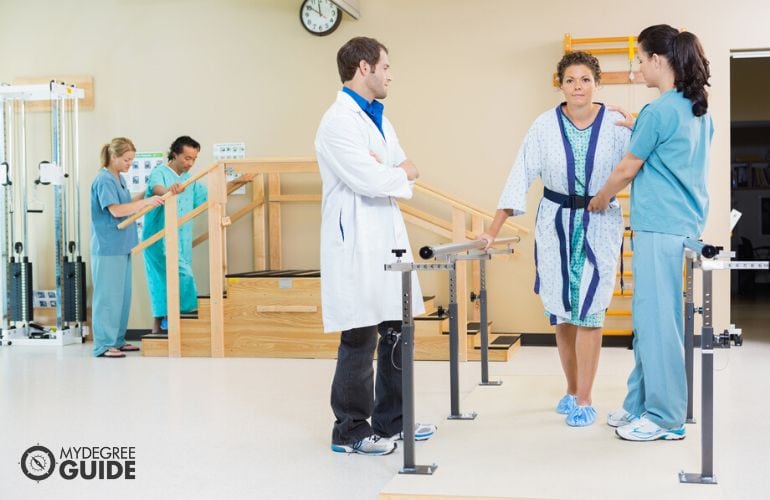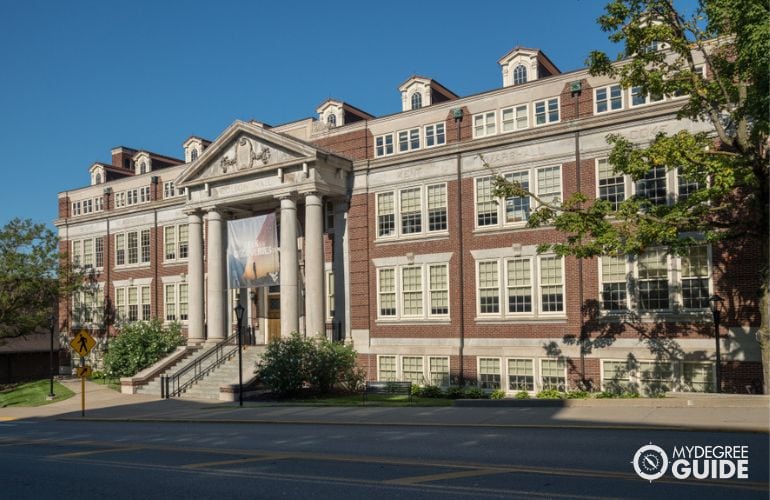Learning how to become a physical therapist could be the first step toward embarking on this exciting career path.

Physical therapists are healthcare providers who can make a lasting difference for people recovering from injuries, surgeries, and other physical difficulties.
Editorial Listing ShortCode:
As you explore what it takes to become a physical therapist, you can decide whether physical therapist training is the right college choice for you. If it is, you’ll study the human body, the healthcare system, and the best strategies for therapeutic intervention.
How to Become a Physical Therapist

Becoming a physical therapist is a multi-step process that begins with your college education and leads to state licensure. Here are the typical steps:
- Complete a bachelor’s degree. You can choose your major since there’s not a set field of study required for physical therapist schooling. You are required to take prerequisite courses, though. A major like kinesiology or biology would provide the necessary background for PT school.
- Work as a volunteer. Schools often require applicants to have completed a set number of hours as a volunteer or an intern in a physical therapy setting.
- Enroll for your doctorate. The required degree for practicing physical therapists is a Doctor of Physical Therapy (DPT) degree. You may want to apply to multiple accredited schools and make your final enrollment decision after receiving acceptance letters. Once you begin your program, you can expect it to take about 3 years. You’ll complete courses, engage in labs, and gain hands-on clinical experience during an internship.
- Take the National Physical Therapy Examination (NPTE). After graduation, you can sit for this professional exam. It is administered by the Federation of State Boards of Physical Therapy (FSBPT). You’re required to receive a passing score before you can begin your PT career.
- Pursue licensure. You can consult your state’s licensing board to learn what is required for obtaining a PT license in your state.
- Specialize in an area of your choice. As a licensed PT, you might want to become nationally certified in a particular subfield of physical therapy. The requirements for board certification include a residency and an exam. Specialization is optional but can be beneficial for your career.
- Keep learning. To maintain your license, you will probably earn continuing education credits so that you’ll be eligible for renewal every few years.
This is a general overview of the process of becoming a physical therapist, but your path to a PT career may look somewhat different. In particular, your state’s requirements may influence the process. You can consult your state’s licensing board to learn more about the steps you’re required to take.
5 Things You Can Do as a Physical Therapist
Studying physical therapy could help prepare you for various careers that involve helping people. You might want to work in healthcare, fitness, education, or a role that combines a few of those fields.
1. Physical Therapist

Working as a physical therapist, you could help people regain movement in parts of their body that are injured or affected by chronic conditions. Your work might also help to lessen their pain.
Editorial Listing ShortCode:
PTs often work in private offices, hospitals, and nursing homes. Some are self-employed.
2. Physical Therapist Assistant

Before you are a licensed physical therapist, you could gain experience as a physical therapist assistant. As an assistant, you’d help patients with exercises and movements. You’d carry out your work under the supervision of a physical therapist.
Assistants usually need a PT associate degree and a license.
3. Physical Therapy Instructor

If you’re passionate about education, you might be able to teach students who want to work in the physical therapy field as assistants or therapists.
A DPT may qualify you only for entry-level teaching roles, such as being an adjunct instructor. With further education, you might be able to take a full-time professor position and start working toward tenured status.
4. Exercise Physiologist

As an exercise physiologist, you could help people learn exercises to improve their physical well-being. Some people work with exercise physiologists after scares with their heart or lung health.
Others may need fitness support to help them manage their chronic health issues. Many exercise physiologists are self-employed, and others work for hospitals.
5. Recreational Therapist

You could use movement activities and other forms of recreation to help people with various conditions. Recreational therapy can be beneficial for patients with physical health problems or mental health concerns.
Editorial Listing ShortCode:
As a recreational therapist, you could work for a hospital, a government agency, or a skilled nursing facility.
Physical Therapy Specialty Areas

After getting your physical therapist degree, you could decide to pursue a specialty. That would demonstrate your expertise as a physical therapy professional and could lead to new job opportunities.
Here are some common PT specialty areas:
- Geriatrics. If you specialize in working with older adults, you’ll support people as they deal with conditions like arthritis, cognitive decline, and osteoporosis.
- Heart and lungs. As a pulmonary and cardiovascular specialist, you could assist patients with chronic conditions and those recovering from surgery.
- Orthopedics. As a physical therapist with a specialist in orthopedics, you could treat injuries and other issues related to the muscular, skeletal, and neurovascular systems.
- Pediatrics. In this specialty, you would focus on treating young patients, particularly those with developmental disorders and chronic conditions such as cerebral palsy or muscular dystrophy.
- Sports. You could spend your physical therapy career working with students, casual, or professional athletes to help them prevent or recover from sports-related injuries.
The requirements necessary for becoming a board-certified PT specialist include gaining thousands of clinical experience hours, completing a residency, and passing a specialty exam.
Physical Therapy Careers and Salaries

If you’re interested in helping people achieve optimal strength and range of motion, there are a variety of careers you can consider.
According to the Bureau of Labor Statistics, the median annual salary for healthcare practitioners and technical workers is $77,750.
| Careers | Annual Median Salaries |
| Medical and Health Services Managers | $104,830 |
| Postsecondary Health Specialties Teachers | $100,300 |
| Physical Therapists | $97,720 |
| Physical Therapist Assistants | $62,770 |
| Health Education Specialists | $59,990 |
| Athletic Trainers | $53,840 |
| Exercise Physiologists | $51,350 |
| Recreational Therapists | $51,330 |
| Medical Insurance Claims Adjusters, Examiners, and Investigators | $51,310 |
| Physical Therapist Aides | $31,410 |
With additional training, you might be able to transition to a role as a different sort of healthcare provider, such as an audiologist, an osteopathic physician, a chiropractor, or a speech-language pathologist.
Physical Therapy Schools Accreditation

As you select schools for your various stages of physical therapy training, it’s strategic to choose ones that have regional accreditation. You can trust that those are reputable schools. Accredited institutions meet academic standards and have been approved by an official organization.
Editorial Listing ShortCode:
An accredited bachelor’s degree is necessary for getting into a doctoral program, and an accredited DPT is a requirement for certification and licensure. Plus, accreditation may be necessary for using financial aid or transferring credits between schools.
CAPTE Accreditation
For your PT degree, it’s beneficial to look for a college that is accredited by the Commission on Accreditation in Physical Therapy Education (CAPTE). This programmatic accreditation affirms that doctoral programs in physical therapy meet the strict standards of this industry.
By choosing an accredited program, you can trust that your education is fully preparing you to work as a physical therapist after graduation. Plus, an accredited degree is required for anyone who applies to take the physical therapist certification exam.
Is Financial Aid Available?

Many qualifying students receive financial aid for their physical therapy schooling. Your undergraduate college may offer scholarship opportunities. Some doctoral students receive partial or full rides as well. In addition, community or national organizations might grant scholarships or fellowships to students who qualify.
Government aid is another source of funding for many students. As an undergraduate, you might receive grants, loans, or both. Loans, whether state or federal, are usually the type of aid offered to doctoral students. Filling out the Free Application for Federal Student Aid (FAFSA) is often the first step to learning about your financial aid eligibility.
What Is a Physical Therapist?

A physical therapist is a healthcare professional who helps people improve how well their body parts move or function. Therapists use exercises, massage, cold therapy, and other interventions to accomplish this goal.
Physical therapists can make a difference for people who are injured or have recently had surgery. They also help patients who have chronic conditions that affect their mobility. While physical therapists are healthcare providers, they are not medical doctors.
To become a physical therapist, a person must hold a doctorate in the field. Passing a national exam and becoming licensed by your state is required as well.
What Does a Physical Therapist Do?

Physical therapists spend a lot of time helping patients do exercises to improve their strength, mobility, and flexibility. The therapies and interventions that PTs provide can also alleviate patients’ pain.
A physical therapy professional can also help people use various mobility devices, such as wheelchairs, prosthetics, or orthotics. Sometimes, working with a PT can help a patient graduate out of braces or other mobility supports. Physical therapy careers involve diagnosing physical problems and developing treatment plans. Documenting patients’ progress is required as well.
Where Do Physical Therapists Work?

According to the Bureau of Labor Statistics, over one-third of physical therapists work in private practice settings. Many others work in hospitals or for home healthcare services. Physical therapists can also find jobs in skilled nursing facilities and rehabilitation centers.
Some employers hire physical therapists to work with certain populations. For example, athletic facilities may hire PTs to work with their athletes. Schools may have PTs to support students with physical disabilities. Physical therapists can work for employers or be self-employed.
How Much Does a Physical Therapist Make?

According to the Bureau of Labor Statistics, most physical therapists earn between $67,910 and $128,830 each year. The highest salaries usually go to those who work for home healthcare agencies, nursing homes, and hospitals. Those who work in private practice clinics generally have lower salaries.
Editorial Listing ShortCode:
Physical therapist assistants can often make $43,340 to $85,230, depending on their experience level and employer. The average income for athletic trainers ranges from $39,670 to $78,000. Schools often pay the highest wages. Exercise physiologists typically make between $39,250 and $77,980. Those employed by government agencies often have significantly higher wages than those employed elsewhere.
What Are the Education Requirements for a Physical Therapist?

To become a physical therapist, you’re required to earn at least two college degrees. After becoming certified and licensed, you could choose to continue your education with a specialization.
- Bachelor’s degree. You can select any major with courses that are relevant to healthcare and physical therapy.
- Doctor of Physical Therapy (DPT). For this advanced degree, you’ll take classes and practice your skills in clinical settings.
- Residency and board certification. As you prepare for specialty certification, you might study geriatrics, women’s health, or pediatrics. You’ll work with a mentor and learn to provide evidence-based care.
Maintaining your license may require ongoing professional development.
How Long Does It Take to Become a Physical Therapist?

You can expect to spend 6 to 8 years completing your initial physical therapy training. For most full-time students, the bachelor’s degree takes about 4 years, but online studies may speed up the process a bit. With full-time enrollment, it’s common to finish a DPT in 3 years. Part-time programs for working students may last about 4 years.
Some colleges offer a dual bachelors-doctorate program. Combining the two degrees into a joint program can be a time-saver. Most joint programs are designed to last about 6 years. Completing a residency and board certification will add time to your PT education.
What’s the Difference Between a Physical Therapist vs. Occupational Therapist?
Occupational therapy and physical therapy are two different healthcare careers that you could consider for improving movement.
| Physical Therapists | Occupational Therapists |
|
|
Occupational therapists and physical therapists often collaborate. The above salary data is from the Bureau of Labor Statistics.
What’s the Difference Between a Physical Therapist vs. Chiropractor?
As either a physical therapist or a chiropractor, you could make a difference in how people physically feel and how well they can move.
| Physical Therapists | Chiropractors |
|
|
The above salary data is from the Bureau of Labor Statistics. Neither physical therapists nor chiropractors are medical doctors.
Getting Your Physical Therapy Degree Online

Physical therapy can be a rewarding career because it provides opportunities to help people live with less pain and greater mobility.
If you want to become a physical therapist, now might be the time to start the process. After completing a related bachelor’s degree, you can then enroll for your physical therapy doctorate.
Earning your bachelor’s degree online could be a convenient way to complete that step. Online studies are flexible, and they’re often faster, too. After that, you might also be able to earn your Doctor of Physical Therapy online or through a hybrid program.
You could start your journey by looking at accredited physical therapy schools today!

